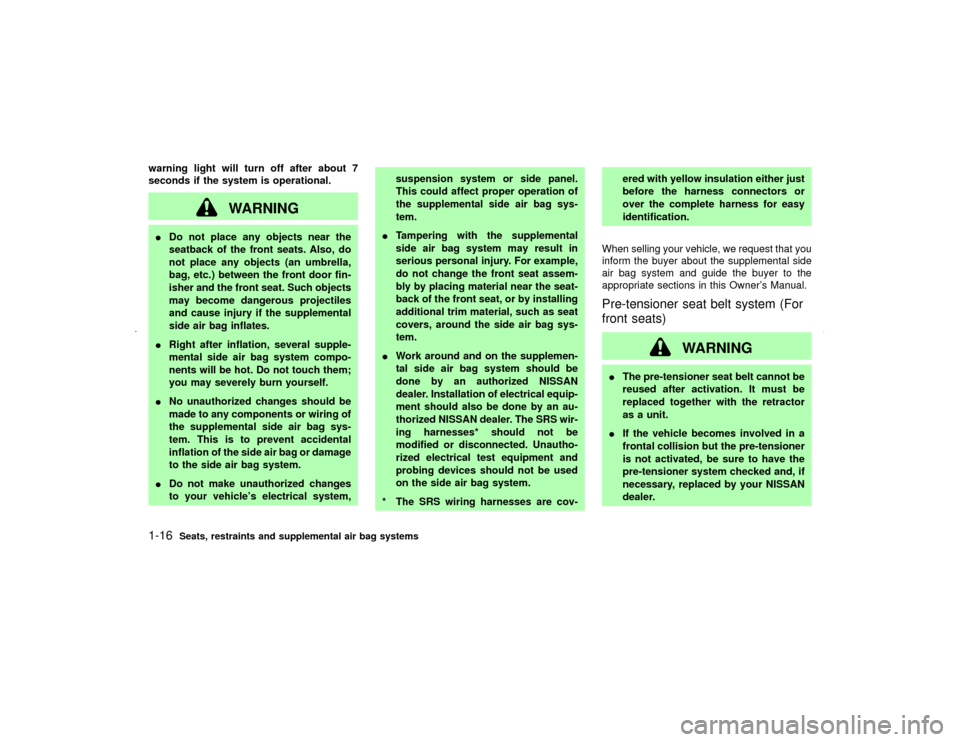2002 NISSAN MAXIMA air suspension
[x] Cancel search: air suspensionPage 19 of 247

When the supplemental front air bag inflates, a
fairly loud noise may be heard, followed by
release of smoke. This smoke is not harmful
and does not indicate a fire. Care should be
taken not to inhale it, as it may cause irritation
and choking. Those with a history of a breath-
ing condition should get fresh air promptly.
Supplemental front air bags, along with the
use of seat belts, helps to cushion the impact
force on the face and chest of the front occu-
pants. They can help save lives and reduce
serious injuries. However, an inflating front air
bag may cause facial abrasions or other inju-
ries. Front air bags do not provide restraint to
the lower body.
The seat belts should be correctly worn and
the driver and passenger seated upright as far
as practical away from the steering wheel or
dash board. The supplemental front air bags
inflates quickly in order to help protect the front
occupants. Because of this, the force of the
front air bag inflating can increase the risk of
injury if the occupant is too close to, or is
against, the air bag module during inflation.
The air bag will deflate quickly after the colli-
sion is over.
After turning the ignition key to the ON
position, the supplemental air bag warning
light illuminates. The supplemental air bagwarning light will turn off after about 7
seconds if the system is operational.
WARNING
IDo not place any objects on the steer-
ing wheel pad or on the instrument
panel. Also, do not place any objects
between any occupant and the steer-
ing wheel or instrument panel. Such
objects may become dangerous pro-
jectiles and cause injury if the supple-
mental front air bag inflates.
IRight after inflation, several air bag
system components will be hot. Do
not touch them; you may severely
burn yourself.
INo unauthorized changes should be
made to any components or wiring of
the supplemental front air bag sys-
tem. This is to prevent accidental
inflation of the air bag or damage to
the air bag system.
IDo not make unauthorized changes
to your vehicle's electrical system,suspension system or front end
structure. This could affect proper
operation of the supplemental air bag
system.
ITampering with the supplemental
front air bag system may result in
serious personal injury. Tampering
includes changes to the steering
wheel and the instrument panel as-
sembly by placing material over the
steering wheel pad, above the dash-
board, or by installing additional trim
material around the air bag system.
IWork around and on the supplemen-
tal front air bag system should be
done by an authorized NISSAN
dealer. Installation of electrical equip-
ment should also be done by an au-
thorized NISSAN dealer. The SRS wir-
ing harnesses* should not be
modified or disconnected. Unautho-
rized electrical test equipment and
probing devices should not be used
on the air bag system.
* The SRS wiring harnesses are cov-
1-14
Seats, restraints and supplemental air bag systems
Z
01.9.21/A33-D/V5.0
X
Page 21 of 247

warning light will turn off after about 7
seconds if the system is operational.
WARNING
IDo not place any objects near the
seatback of the front seats. Also, do
not place any objects (an umbrella,
bag, etc.) between the front door fin-
isher and the front seat. Such objects
may become dangerous projectiles
and cause injury if the supplemental
side air bag inflates.
IRight after inflation, several supple-
mental side air bag system compo-
nents will be hot. Do not touch them;
you may severely burn yourself.
INo unauthorized changes should be
made to any components or wiring of
the supplemental side air bag sys-
tem. This is to prevent accidental
inflation of the side air bag or damage
to the side air bag system.
IDo not make unauthorized changes
to your vehicle's electrical system,suspension system or side panel.
This could affect proper operation of
the supplemental side air bag sys-
tem.
ITampering with the supplemental
side air bag system may result in
serious personal injury. For example,
do not change the front seat assem-
bly by placing material near the seat-
back of the front seat, or by installing
additional trim material, such as seat
covers, around the side air bag sys-
tem.
IWork around and on the supplemen-
tal side air bag system should be
done by an authorized NISSAN
dealer. Installation of electrical equip-
ment should also be done by an au-
thorized NISSAN dealer. The SRS wir-
ing harnesses* should not be
modified or disconnected. Unautho-
rized electrical test equipment and
probing devices should not be used
on the side air bag system.
* The SRS wiring harnesses are cov-ered with yellow insulation either just
before the harness connectors or
over the complete harness for easy
identification.
When selling your vehicle, we request that you
inform the buyer about the supplemental side
air bag system and guide the buyer to the
appropriate sections in this Owner's Manual.
Pre-tensioner seat belt system (For
front seats)
WARNING
IThe pre-tensioner seat belt cannot be
reused after activation. It must be
replaced together with the retractor
as a unit.
IIf the vehicle becomes involved in a
frontal collision but the pre-tensioner
is not activated, be sure to have the
pre-tensioner system checked and, if
necessary, replaced by your NISSAN
dealer.
1-16
Seats, restraints and supplemental air bag systems
Z
01.9.21/A33-D/V5.0
X
Page 233 of 247

trailer is hitched. Do not drive the vehicle if
it has an abnormal nose-up or nose-down
condition; check for improper tongue load,
overload, worn suspension or other pos-
sible causes of either condition.
IAlways secure items in the trailer to prevent
load shifts while driving.
IBe certain your rear view mirrors conform to
all federal, state or local regulations. If not,
install any mirrors required for towing be-
fore driving the vehicle.
Trailer towing tipsIn order to gain skill and an understanding of
the vehicle's behavior, you should practice
turning, stopping and backing up in an area
which is free from traffic. Steering stability, and
braking performance will be somewhat differ-
ent than under normal driving conditions.
IAlways secure items in the trailer to prevent
load shift while driving.
IAvoid abrupt starts, acceleration or stops.
IAvoid sharp turns or lane changes.
IAlways drive your vehicle at a moderate
speed.
IAlways block the wheels on both vehicle
and trailer when parking. Parking on aslope is not recommended; however, if you
must do so, and if your vehicle is equipped
with automatic transmission, first block the
wheels and apply the parking brake, and
then move the transmission selector lever
into the P (Park) position. If you move the
selector lever to the P (Park) position be-
fore blocking the wheels and applying the
parking brake, transmission damage could
occur.
IWhen going down a hill, shift into a lower
gear and use the engine braking effect.
When ascending a long grade, downshift
the transmission to a lower gear and reduce
speed to reduce chances of engine over-
loading and/or overheating.
IIf the engine coolant rises to an extremely
high temperature when the air conditioning
system is on, turn off the air conditioner.
Coolant heat can be additionally vented by
opening the windows, switching the fan
control to high and setting the temperature
control to the HOT position.
ITrailer towing requires more fuel than nor-
mal circumstances.
IAvoid towing a trailer for the first 500 miles
(800 km).
IHave your vehicle serviced more often thanat intervals specified in the recommended
maintenance schedule.
IWhen making a turn, your trailer wheels will
be closer to the inside of the turn than your
vehicle wheels. To compensate for this,
make a larger than normal turning radius
during the turn.
ICrosswinds and rough roads will adversely
affect vehicle/trailer handling, possibly
causing vehicle sway. When being passed
by larger vehicles, be prepared for possible
changes in crosswinds that could affect
vehicle handling. If swaying does occur,
firmly grip the steering wheel, steer straight
ahead, and immediately (but gradually) re-
duce vehicle speed. This combination will
help stabilize the vehicle. Never increase
speed.
IBe careful when passing other vehicles.
Passing while towing a trailer requires con-
siderably more distance than normal pass-
ing. Remember the length of the trailer
must also pass the other vehicle before you
can safely change lanes.
ITo maintain engine braking efficiency and
electrical charging performance, do not use
fifth gear (manual transmission) or over-
drive (automatic transmission).9-18
Technical and consumer information
Z
01.9.21/A33-D/V5.0
X